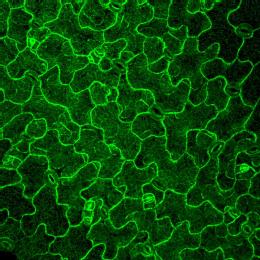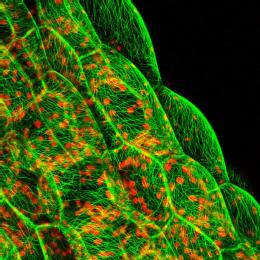Juliet Coates
 |
 |
leaf architecture in arabidopsis |
plant cell architecture in arabidopsis |
What got you interested in this area of science?
At University I learnt about how cells in a complex many-celled (or multicellular) organism such as an animal or a plant use molecules called proteins to talk to one another. I became fascinated by this idea of cell communication and wanted to find out more about how it occurred at the molecular level. This led to an interest in Developmental Biology, which is the study of how a many-celled organism arises from one single cell, a fertilised egg. Development of a multicellular organism involves lots of communication between cells so that they know what to become (e.g. liver cell, brain cell) and how to get to the right place (top, bottom, left, right).
How is the work you are currently doing relevant to everyday life?
Currently we are interested in how plant development has evolved. This may not sound all that relevant to real life, but let's put it in perspective. All the complex many-celled land plants (trees, flowers, grass, shrubs, mosses, ferns etc) that we see on the planet today arose from a single common ancestor about half a billion years ago. That ancestor somehow managed to go from living in water to living on the land. If this event had not happened all the plants that we rely on today for oxygen, food, fuel, building and clothing would not exist, and so society as we know it would not exist either!
What does your research hope to achieve?
By moving from water to land plants had to overcome huge environmental challenges, particularly the risk of dessication, or drying out. If we can understand how land plant developmental mechanisms have evolved, then in the future we hope to be able to use this knowledge to grow plants that are EVEN BETTER at facing the current challenges of life on land. Water shortage is a big problem in many parts of the world, and engineering crop plants that are better equipped to deal with drought could make a huge difference to world food supply. In addition, if we understand how plant cells have evolved to have the chemical composition that they do, we are more likely to be able to find ways of breaking plants back down into their component parts, which is basically what we do during biofuel production.
So, we are studying a fundamental scientific problem, trying to understand cellular processes that have evolved over many millions of years. We hope that the knowledge gained from this "basic science", which tries to understand fundamental questions about life can then be applied to current real-world problems in a useful way.
Briefly, what does the image show?
Arabidopsis thaliana (mustard cress) is a little weed that plant scientists use as a "model organism" to study fundamental aspects of plant biology, as it is easy to work with in the laboratory. Discoveries made in Arabidopsis about plant growth, physiology and responses to the environment can be applied to biofuel- and food crops. Thus, we can breed a new generation of crop plants that are well-equipped to grow in adverse conditions and provide the biomass and yield needed to sustain the world's ever-changing and growing energy and food requirements. This image shows filamentous structures called mictrotubules (green) in Arabidopsis leaf cells. Microtubules help to ensure the correct production of cellulose fibres by plant cells. Cellulose is the plant material that we can break down to produce biofuel. By manipulating microtubules, plant scientists may be able to produce plants that make more cellulose, or cellulose that is easier to break down for fuel.

